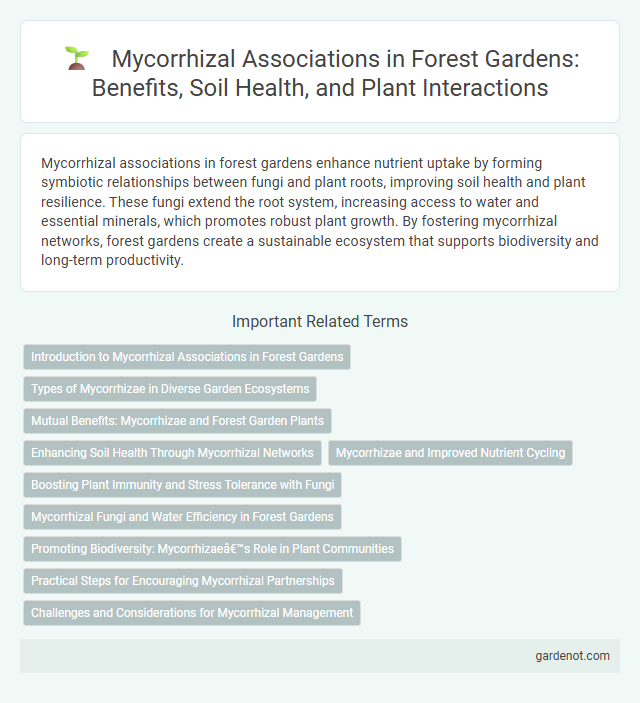Mycorrhizal associations in forest gardens enhance nutrient uptake by forming symbiotic relationships between fungi and plant roots, improving soil health and plant resilience. These fungi extend the root system, increasing access to water and essential minerals, which promotes robust plant growth. By fostering mycorrhizal networks, forest gardens create a sustainable ecosystem that supports biodiversity and long-term productivity.
Introduction to Mycorrhizal Associations in Forest Gardens
Mycorrhizal associations in forest gardens form symbiotic relationships between tree roots and specialized fungi, enhancing nutrient and water absorption. These fungal networks improve soil structure and increase resilience against environmental stress, promoting healthier and more productive forest ecosystems. Understanding mycorrhizal interactions is crucial for designing sustainable forest gardens that maximize plant growth and biodiversity.
Types of Mycorrhizae in Diverse Garden Ecosystems
Mycorrhizal associations in forest gardens primarily involve two major types: arbuscular mycorrhizae (AM) and ectomycorrhizae (ECM), each supporting specific plant species and soil conditions. Arbuscular mycorrhizae penetrate root cells and enhance nutrient uptake in herbaceous plants and many crops, while ectomycorrhizae form a sheath around roots, benefiting trees and shrubs by improving water absorption and disease resistance. Understanding these distinct mycorrhizal types is crucial for optimizing plant health and ecosystem resilience in diverse garden environments.
Mutual Benefits: Mycorrhizae and Forest Garden Plants
Mycorrhizal fungi form symbiotic relationships with forest garden plants, enhancing nutrient uptake by expanding the root system's efficiency in absorbing phosphorus and nitrogen. This association improves plant health and growth, leading to increased biomass and resilience against environmental stressors. In return, plants supply fungi with carbohydrates derived from photosynthesis, creating a mutualistic exchange critical for sustainable forest garden ecosystems.
Enhancing Soil Health Through Mycorrhizal Networks
Mycorrhizal associations form intricate networks between tree roots and fungi, significantly enhancing nutrient uptake and soil structure in forest gardens. These symbiotic relationships improve phosphorus absorption, increase water retention, and promote beneficial microbial activity, leading to healthier, more resilient soil ecosystems. Establishing diverse mycorrhizal partnerships supports plant growth and carbon sequestration, essential for sustainable forest garden development.
Mycorrhizae and Improved Nutrient Cycling
Mycorrhizae form symbiotic associations with forest garden plants, enhancing nutrient uptake by expanding the root surface area and facilitating access to phosphorus and micronutrients. This relationship improves soil structure and accelerates nutrient cycling by promoting microbial activity and organic matter decomposition. Consequently, mycorrhizal networks increase plant health and productivity, supporting sustainable forest garden ecosystems.
Boosting Plant Immunity and Stress Tolerance with Fungi
Mycorrhizal associations enhance forest garden plant immunity by facilitating nutrient exchange that fortifies root systems against pathogens. These symbiotic fungi improve drought and temperature stress tolerance by increasing water uptake and activating plant defense mechanisms. Integrating mycorrhizal fungi in forest gardens promotes resilient ecosystems capable of sustaining diverse plant species under environmental stress.
Mycorrhizal Fungi and Water Efficiency in Forest Gardens
Mycorrhizal fungi form symbiotic relationships with plant roots, enhancing water absorption by increasing root surface area and improving soil structure in forest gardens. These fungi facilitate efficient water uptake during dry periods, promoting drought resilience and plant health. Integration of mycorrhizal fungi into forest garden systems optimizes water use efficiency, supporting sustainable growth and productivity.
Promoting Biodiversity: Mycorrhizae’s Role in Plant Communities
Mycorrhizal associations enhance forest garden biodiversity by facilitating nutrient exchange between fungi and diverse plant species, promoting robust plant growth and resilience. These symbiotic networks improve soil structure and nutrient cycling, supporting a wider range of flora and fauna within the ecosystem. The presence of mycorrhizae fosters plant community diversity by enabling interspecies communication and resource sharing, leading to more stable and productive forest gardens.
Practical Steps for Encouraging Mycorrhizal Partnerships
In forest gardens, encouraging mycorrhizal partnerships enhances nutrient uptake and soil health by applying organic mulches and minimizing soil disturbance to preserve fungal networks. Introducing native mycorrhizal inoculants around plant root zones supports the establishment of symbiotic fungi crucial for tree and shrub growth. Maintaining diverse plant species and avoiding excessive fertilizer use further promotes robust mycorrhizal communities essential for ecosystem resilience.
Challenges and Considerations for Mycorrhizal Management
Managing mycorrhizal associations in forest gardens requires careful consideration of soil health, host plant compatibility, and environmental conditions to ensure optimal symbiotic benefits. Challenges include variability in fungal species effectiveness, potential competition with native microbiota, and the impact of soil disturbance on fungal networks. Effective mycorrhizal management demands ongoing monitoring and adaptive strategies to maintain fungal diversity and support plant nutrient uptake.
Mycorrhizal association Infographic

 gardenot.com
gardenot.com